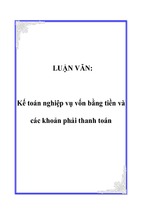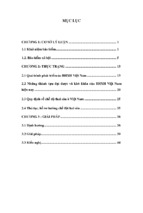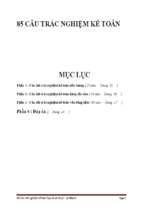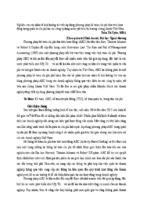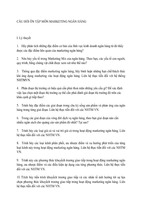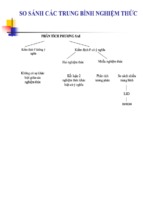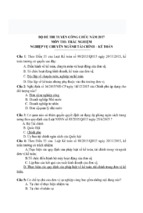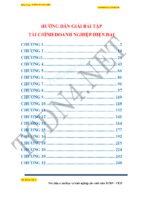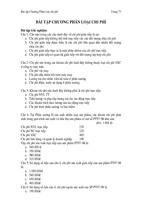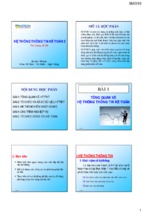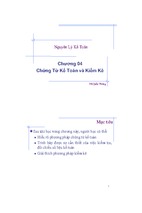Principles of accounting
D. Leiwy
AC1025
2013
Undergraduate study in
Economics, Management,
Finance and the Social Sciences
This subject guide is for a 100 course offered as part of the University of London
International Programmes in Economics, Management, Finance and the Social Sciences.
This is equivalent to Level 4 within the Framework for Higher Education Qualifications in
England, Wales and Northern Ireland (FHEQ).
For more information about the University of London International Programmes
undergraduate study in Economics, Management, Finance and the Social Sciences, see:
www.londoninternational.ac.uk
This guide was prepared for the University of London International Programmes by:
Danny Leiwy, Department of Accounting, The London School of Economics and
Political Science.
It draws on material in the previously published editions of the guide by:
Dr Jennifer Ireland, formerly of the Department of Accounting and Finance, The London School
of Economics and Political Science.
This is one of a series of subject guides published by the University. We regret that due to
pressure of work the authors are unable to enter into any correspondence relating to, or arising from, the guide. If you have any comments on this subject guide, favourable or unfavourable, please use the form at the back of this guide.
University of London International Programmes
Publications Office
Stewart House
32 Russell Square
London WC1B 5DN
United Kingdom
www.londoninternational.ac.uk
Published by: University of London
© University of London 2013
The University of London asserts copyright over all material in this subject guide except where
otherwise indicated. All rights reserved. No part of this work may be reproduced in any form,
or by any means, without permission in writing from the publisher. We make every effort to
respect copyright. If you think we have inadvertently used your copyright material, please let
us know.
Contents
Contents
Introduction ............................................................................................................ 1
The study of accounting ................................................................................................. 1
Aims of the course......................................................................................................... 2
Learning outcomes ........................................................................................................ 2
Essential reading ........................................................................................................... 2
Further reading.............................................................................................................. 3
Online study resources ................................................................................................... 3
Structure of the subject guide ........................................................................................ 5
How to use the subject guide......................................................................................... 5
Examination advice........................................................................................................ 7
List of abbreviations used in this subject guide ............................................................. 10
Chapter 1: Accounting in context ......................................................................... 13
Aims .......................................................................................................................... 13
Learning outcomes ..................................................................................................... 13
Essential reading ......................................................................................................... 13
Introduction ................................................................................................................ 13
What is accounting? .................................................................................................... 14
Accounting theory and practice .................................................................................... 17
Accounting information and its uses ............................................................................ 17
Financial accounting .................................................................................................... 18
Management accounting ............................................................................................. 19
Summary ..................................................................................................................... 19
Reminder of your learning outcomes ............................................................................ 20
Sample examination question ...................................................................................... 20
Section 1: Financial accounting ............................................................................ 21
Chapter 2: Fundamentals of financial accounting ................................................ 23
Aims .......................................................................................................................... 23
Learning outcomes ..................................................................................................... 23
Essential reading ......................................................................................................... 23
Introduction ................................................................................................................ 23
An introduction to the financial statements .................................................................. 24
Accounting characteristics and concepts, bases and policies ......................................... 33
Summary ..................................................................................................................... 35
Reminder of your learning outcomes ............................................................................ 36
Sample examination questions ..................................................................................... 36
Chapter 3: Data processing .................................................................................. 37
Aims ........................................................................................................................... 37
Learning outcomes ...................................................................................................... 37
Essential reading ......................................................................................................... 37
Introduction ................................................................................................................ 37
One transaction: two effects ........................................................................................ 38
Recording transactions: books of prime entry ............................................................... 40
Double-entry book-keeping ......................................................................................... 44
Trial balance ................................................................................................................ 52
i
AC1025 Principles of accounting
Getting it right: internal control.................................................................................... 55
Summary ..................................................................................................................... 57
Reminder of your learning outcomes ............................................................................ 57
Sample examination question ...................................................................................... 57
Chapter 4: Preparing financial statements 1........................................................ 59
Aims .......................................................................................................................... 59
Learning outcomes ...................................................................................................... 59
Essential reading ......................................................................................................... 59
Introduction ................................................................................................................ 59
Inventory, purchases and sales ..................................................................................... 60
Accruals and prepayments ........................................................................................... 64
Bad and doubtful debts ............................................................................................... 66
Depreciation of non-current assets ............................................................................... 70
Disposal of non-current assets ..................................................................................... 74
Revaluation of land and buildings ................................................................................ 76
Summary ..................................................................................................................... 77
Reminder of your learning outcomes ............................................................................ 77
Sample examination questions ..................................................................................... 78
Chapter 5: Preparing financial statements 2........................................................ 79
Aims .......................................................................................................................... 79
Learning outcomes ...................................................................................................... 79
Essential reading ......................................................................................................... 79
Introduction ................................................................................................................ 79
Preparing the statement of financial position and income statement ............................. 80
Incomplete information................................................................................................ 90
Summary ................................................................................................................... 100
Reminder of your learning outcomes .......................................................................... 100
Sample examination question .................................................................................... 100
Chapter 6: Preparing financial statements 3...................................................... 103
Aims ........................................................................................................................ 103
Learning outcomes .................................................................................................... 103
Essential reading ....................................................................................................... 103
Introduction .............................................................................................................. 103
Different formats for different purposes...................................................................... 104
Preparing company accounts ..................................................................................... 108
Preparing the cash flow statement ............................................................................. 113
Summary ................................................................................................................... 120
Reminder of your learning outcomes .......................................................................... 121
Sample examination questions ................................................................................... 121
Chapter 7: Using and understanding financial statements ................................ 127
Aims ........................................................................................................................ 127
Learning outcomes .................................................................................................... 127
Essential reading ....................................................................................................... 127
Introduction .............................................................................................................. 127
Ratio analysis ............................................................................................................ 128
Writing a report ......................................................................................................... 141
Summary ................................................................................................................... 142
Reminder of your learning outcomes .......................................................................... 142
Sample examination question .................................................................................... 143
ii
Contents
Section 2: Management accounting ................................................................... 145
Chapter 8: Fundamentals of management accounting ..................................... 147
Aims ........................................................................................................................ 147
Learning outcomes .................................................................................................... 147
Essential reading ....................................................................................................... 147
Introduction .............................................................................................................. 147
Planning and coordination ......................................................................................... 148
Control, communication and motivation ..................................................................... 149
Information for decision-making ................................................................................ 150
Summary ................................................................................................................... 150
Reminder of your learning outcomes .......................................................................... 151
Chapter 9: Cost accounting ................................................................................ 153
Aims ........................................................................................................................ 153
Learning outcomes .................................................................................................... 153
Essential reading ....................................................................................................... 153
Introduction .............................................................................................................. 153
Understanding costs .................................................................................................. 154
Inventory valuation – marginal costing ....................................................................... 157
Inventory valuation – full costing ............................................................................... 157
Effects of different inventory valuation methods ......................................................... 162
Summary ................................................................................................................... 164
Reminder of your learning outcomes .......................................................................... 165
Sample examination questions ................................................................................... 166
Chapter 10: Making decisions 1 ......................................................................... 169
Aims ........................................................................................................................ 169
Learning outcomes .................................................................................................... 169
Essential reading ....................................................................................................... 169
Introduction .............................................................................................................. 169
Cost-volume-profit analysis........................................................................................ 170
Relevant costs ........................................................................................................... 174
Limiting factors.......................................................................................................... 177
Summary ................................................................................................................... 178
Reminder of your learning outcomes .......................................................................... 179
Sample examination questions ................................................................................... 179
Chapter 11: Making decisions 2 ......................................................................... 183
Aims ......................................................................................................................... 183
Learning outcomes .................................................................................................... 183
Essential reading ....................................................................................................... 183
Introduction .............................................................................................................. 183
Capital investments ................................................................................................... 184
Payback period .......................................................................................................... 184
Accounting Rate of Return (ARR) ............................................................................... 188
Summary ................................................................................................................... 189
Reminder of your learning outcomes .......................................................................... 190
Sample examination question .................................................................................... 190
Chapter 12: Making decisions 3 ........................................................................ 191
Aims ........................................................................................................................ 191
Learning outcomes .................................................................................................... 191
Essential reading ....................................................................................................... 191
iii
AC1025 Principles of accounting
Introduction .............................................................................................................. 191
Discounted cash flow techniques ............................................................................... 192
Summary ................................................................................................................... 200
Reminder of your learning outcomes .......................................................................... 200
Sample examination questions ................................................................................... 201
Chapter 13: Planning for the future ................................................................... 203
Aims ........................................................................................................................ 203
Learning outcomes .................................................................................................... 203
Essential reading ....................................................................................................... 203
Introduction .............................................................................................................. 203
Goals and objectives.................................................................................................. 204
Budgets and forecasts ............................................................................................... 205
Working capital management .................................................................................... 209
Summary ................................................................................................................... 211
Reminder of your learning outcomes .......................................................................... 212
Sample examination question .................................................................................... 212
Chapter 14: Budgets for control ......................................................................... 213
Aims ......................................................................................................................... 213
Learning outcomes .................................................................................................... 213
Essential reading ....................................................................................................... 213
Introduction .............................................................................................................. 213
Standard costs........................................................................................................... 214
Behavioural effects of using budgets .......................................................................... 215
Variance analysis – an introduction ............................................................................ 216
Summary ................................................................................................................... 225
Reminder of your learning outcomes .......................................................................... 225
Sample examination question .................................................................................... 226
Appendix 1: Suggested solutions to selected Activities and
Sample examination questions .......................................................................... 227
Chapter 2 .................................................................................................................. 227
Chapter 3 .................................................................................................................. 229
Chapter 4 .................................................................................................................. 232
Chapter 5 .................................................................................................................. 235
Chapter 6 .................................................................................................................. 245
Chapter 7 .................................................................................................................. 258
Chapter 8 .................................................................................................................. 259
Chapter 9 .................................................................................................................. 260
Chapter 10 ................................................................................................................ 263
Chapter 11 ................................................................................................................ 266
Chapter 12 ................................................................................................................ 267
Chapter 13 ................................................................................................................ 272
Chapter 14 ................................................................................................................ 276
Appendix 2: Sample examination papers ........................................................... 279
Before you start ......................................................................................................... 279
Sample examination paper 1 ..................................................................................... 280
Extracts from compound interest tables ...................................................................... 289
Sample examination paper 2 ..................................................................................... 290
Appendix 3: Example of 8-column accounting paper......................................... 301
iv
Introduction
Introduction
This subject guide has been written for those of you who are studying
AC1025 Principles of accounting. The course is intended as a broad
introduction to the subject, both for non-specialist students, and as a
foundation for further study in the area.
The study of accounting
From the outside, accounting can appear to be a purely practical subject.
It would be very easy to focus on just the applications of techniques and
procedures. But accounting is more than just a set of calculations; unless
we can understand and interpret the figures we produce, the calculations
are pointless!
Accounting provides information for a wide variety of different users and
purposes, and its practices can only be properly understood and assessed
in relation to the economic and social environment in which they are
applied. Therefore there are four aspects to this subject:
1. Techniques for recording, calculating, classifying and reporting of
accounting information.
2. The legal and institutional background associated with accounting
information.
3. The economic and administrative problems which the information is
required to solve.
4. The interpretation of reports prepared using 1 in the light of 2 and 3.
The accounting information referred to in 1 need not be financial,
although for our purposes in this course it will almost always be.
The problems referred to in 3 are largely concerned with the planning of,
and control over, the use of economic resources. They are also concerned
with the measurement of income and of various kinds of value changes.
In order to properly interpret accounting information as in 4, and apply
it to the problems in 3, we need to understand the theory and principles
which underlie the techniques in 1.
The study of accounting is traditionally divided into two parts according to
the types of users of the accounting information. Financial accounting
is primarily concerned with the needs of users outside the business (or
other organisation). Therefore it relates to the external control and
management of resources (for example, by shareholders of the company
in which they have invested their funds, or by banks making loans). A
key part of financial accounting is reporting the performance and position
of the business to these external users, via the financial statements.
The form and content of financial statements is usually highly regulated.
In contrast, management accounting is concerned with the needs of
users inside the business. Therefore it relates to the internal control and
management of resources (for example, by the directors, management or
employees of a company). Management accounting statements may be
more detailed than those prepared for external users, and do not normally
need to meet any legal requirements.
1
AC1025 Principles of accounting
Countries around the world organise their economic and financial
activities in different ways so, inevitably, legal requirements, regulation
and administrative procedures also vary across countries. The syllabus for
this course is based on the system pertaining to the UK, but the amount of
institutional material that you need to know is kept to a minimum. Even
though the material in this text is based on the system in the UK, accounting
rules and guidelines around the world are becoming more similar
(converging) as a result of International Financial Reporting Standards
(IFRSs) which are complied with by large companies in most countries. This
is part of a general drive to harmonise international accounting practices.
It is important to note that knowledge of UK Statements of
Standard Accounting Practice (SSAPs), Financial Reporting
Standards (FRSs), and of International Accounting Standards
(IASs) and International Financial Reporting Standards (IRFSs),
is not part of the syllabus.
Aims of the course
The aims of the course are to:
• introduce you to the principles underlying accounting
• enable you to apply, interpret and explain key accounting techniques
• provide a broad understanding of the theory and practice of financial
and management accounting.
The course is intended both for non-specialist students, and as a foundation
for further study in the area.
Learning outcomes
At the end of this course, and having completed the Essential reading and
Activities, you should be able to:
• distinguish between different uses of accounting information and relate
these uses to the needs of different groups of users
• explain the limitations of such statements and their analysis
• categorise cost behaviour, and prepare and contrast inventory valuations
under different costing methods
• describe the budgeting process and discuss the use of budgets in
planning and control
• explain, discuss and apply relevant techniques to aid internal users in
decision-making.
Essential reading
Leiwy, D. and R. Perks Accounting: understanding and practice. (Maidenhead:
McGraw-Hill, 2013) fourth edition [ISBN 9780077139131].
You are strongly advised to buy this textbook, which is referred to in every
chapter of this subject guide and has many examples and both self-testing
and assessment questions closely related to this course. The textbook also
has a companion website: www.mcgraw-hill.co.uk/textbooks/leiwy
2
Detailed reading references in this subject guide refer to the edition of the
set textbook listed above. New editions of this textbook may have been
published by the time you study this course. You can use a more recent
edition; use the detailed chapter and section headings and the index to
identify relevant readings. Also check the virtual learning environment
(VLE) regularly for updated guidance on readings.
Introduction
Further reading
Please note that as long as you read the Essential reading you are then free
to read around the subject area in any text, paper or online resource. You
will need to support your learning by reading as widely as possible and by
thinking about how these principles apply in the real world. To help you
read extensively, you have free access to the VLE and University of London
Online Library (see below).
Accounting is an evolving and, at times, controversial subject. You are
encouraged to stay informed of the current issues in accounting. These
issues are often reported in the press, so you may do this by reading
the financial pages of a quality daily, or weekly, newspaper. In addition,
specialist publications that are worth reading on a regular basis include
economia, the official monthly journal of the Institute of Chartered
Accountants in England and Wales (ICAEW), Accountancy, formerly
the official monthly journal of the ICAEW, and Accountancy Age which
is available online at www.accountancyage.com. Journals of other
professional accountancy bodies in the UK and elsewhere are also suitable.
Press, comment and other information can also be found at
www.accountingweb.co.uk
In recent times, accounting for pensions and financial instruments have
been regular features in the UK news. Your country may have very
different accounting issues. You may not be able to understand all the
technical details, but you should try to understand the main arguments.
Who do you think is right, and why? What may be the real motivations
behind the arguments? How do the policy-makers respond? What are the
causes of accounting scandals that occur? What do you think can be done
to prevent these scandals, and why?
Reference books
Nobes, C. The Penguin dictionary of accounting. (London: Penguin Books, 2006)
second edition [ISBN 9780141025254].
Owen, G. and J. Law A dictionary of accounting. (Oxford: Oxford Paperbacks,
2010) fourth edition [ISBN 9780199563050].
These (or any similar) dictionaries of accounting provide a quick source
of reference for any new terms you meet in this course. You may find
a dictionary particularly useful when you approach this course for the
first time, as accounting terminology can sometimes cause unnecessary
confusion. You should be aware that precise terminology, particularly
with respect to financial reporting terms, may differ from one country
to another. If you do not have a dictionary of accounting, you should be
able to find the information you need in Leiwy and Perks (2013) which
includes a comprehensive glossary (pp.470–75).
Online study resources
In addition to the subject guide and the Essential reading, it is crucial that
you take advantage of the study resources that are available online for this
course, including the VLE and the Online Library.
You can access the VLE, the Online Library and your University of London
email account via the Student Portal at:
http://my.londoninternational.ac.uk
You should have received your login details for the Student Portal with
your official offer, which was emailed to the address that you gave
3
AC1025 Principles of accounting
on your application form. You have probably already logged in to the
Student Portal in order to register! As soon as you registered, you will
automatically have been granted access to the VLE, Online Library and
your fully functional University of London email account.
If you have forgotten these login details, please click on the ‘Forgotten
your password’ link on the login page.
The VLE
The VLE, which complements this subject guide, has been designed to
enhance your learning experience, providing additional support and a
sense of community. It forms an important part of your study experience
with the University of London and you should access it regularly.
The VLE provides a range of resources for EMFSS courses:
• Self-testing activities: Doing these allows you to test your own
understanding of subject material.
• Electronic study materials: The printed materials that you receive from
the University of London are available to download, including updated
reading lists and references.
• Past examination papers and Examiners’ commentaries: These provide
advice on how each examination question might best be answered.
• A student discussion forum: This is an open space for you to discuss
interests and experiences, seek support from your peers, work
collaboratively to solve problems and discuss subject material.
• Videos: There are recorded academic introductions to the subject,
interviews and debates and, for some courses, audio-visual tutorials
and conclusions.
• Recorded lectures: For some courses, where appropriate, the sessions
from previous years’ Study Weekends have been recorded and made
available.
• Study skills: Expert advice on preparing for examinations and
developing your digital literacy skills.
• Feedback forms.
Some of these resources are available for certain courses only, but we
are expanding our provision all the time and you should check the VLE
regularly for updates.
Making use of the Online Library
The Online Library contains a huge array of journal articles and other
resources to help you read widely and extensively.
To access the majority of resources via the Online Library you will either
need to use your University of London Student Portal login details, or you
will be required to register and use an Athens login:
http://tinyurl.com/ollathens
The easiest way to locate relevant content and journal articles in the
Online Library is to use the Summon search engine.
If you are having trouble finding an article listed in a reading list, try
removing any punctuation from the title, such as single quotation marks,
question marks and colons.
For further advice, please see the online help pages:
www.external.shl.lon.ac.uk/summon/about.php
4
Introduction
Structure of the subject guide
This subject guide is divided into 14 chapters which, with the exception of
the Introduction, are organised in two sections:
• Chapter 1 is a general introduction to the subject and also distinguishes
between financial and management accounting.
• Chapters 2–7 form Section 1 on financial accounting. This section
introduces and explains financial accounting concepts and conventions,
and provides a grounding in double-entry book-keeping and the
preparation of basic financial statements. This section also enables
you to analyse and interpret the information contained in these
financial statements, and to explain their limitations, with reference
to underlying theories and principles. Although a grounding in
double-entry book-keeping is provided, you should note that it is
possible to prepare basic financial statements from both structured
and unstructured information without making use of this technique;
double-entry book-keeping is used by businesses to record financial
transactions as they occur, but if this data is already provided then it
can be directly manipulated for financial reporting purposes.
• Chapters 8–14 form Section 2 on management accounting. This
section introduces a range of management accounting applications and
techniques for planning, decision-making and control. These techniques
are supported by discussion of the underlying theories and principles,
and emphasis is placed on the ability to interpret and critique their use.
• Finally, Appendix 1 gives some suggested solutions to the exercises and
sample examination questions set in the chapters. Appendix 2 contains
two Sample examination papers and extracts from interest (discount
factor) tables.
How to use the subject guide
This subject guide is intended to supplement, not replace, the Essential
reading indicated in the text. The guide relies on the recommended text
(Leiwy and Perks, 2013) to provide the theoretical grounding for the
material and for many definitions, examples and explanations. The subject
guide:
• provides a framework for your study of the subject using the
recommended text
• contains aims and learning outcomes for each topic, and references to
the Essential reading
• acts as a pointer to the most important issues dealt with in the reading
• provides additional explanations where appropriate
• contains additional worked examples, exercises for you to work
through yourself, and sample examination questions.
It is important to attempt all of the exercises and to ensure that you take
the time to fully understand the material covered in each chapter of the
subject guide.
You should complete this Introduction first of all, before progressing to the
other sections of the guide. Thereafter, you are strongly advised to attempt
the work relating to financial accounting (Section 1) in the order in
which it is presented in the guide. However, you may progress to Section
2 (Management accounting) before attempting Chapter 7.1 Although it is
1
It is important
to study Chapters
2–6 on financial
accounting before
starting the material
on management
accounting, because you
will need to understand
both terminology from
the financial accounting
material, and the
way that financial
statements fit together,
in order to understand
all of the material
on management
accounting.
5
AC1025 Principles of accounting
also important to attempt the work relating to management accounting in
the general order in which it is presented in the guide, Chapters 13 and
14 may be attempted (in that order) at any time after you have completed
Chapters 8 and 9.
It is also possible to leave part of Chapter 3 (Data processing) and return
to it at a later date, if it is causing you problems. The section of this
chapter that you may return to later deals with double-entry
book-keeping. You will see that it is not necessary to perform doubleentry book-keeping when preparing financial statements from structured
and unstructured information. The most important part of this chapter to
understand before progressing onwards is the interpretation, rather than
the production, of the trial balance.
It is essential to have a good understanding of the underlying principles
of financial accounting before moving onwards as the steps which
culminate in the preparation (and interpretation) of financial statements
are cumulative. However, you may find that the work on management
accounting falls more readily into separate, albeit related, topics. In
particular, Chapters 10–12, on decision-making techniques, may be
attempted separately from Chapters 13 and 14, on the use of budgets for
planning and control.
Unless indicated otherwise, the order in which you should tackle the work
specified in each chapter is as follows:
1. Read the chapter Aims and Learning outcomes, and the Introduction,
to appreciate what material will be covered in the chapter, and what
you are expected to achieve by the end of it. Bear these in mind as you
work through the chapter.
2. Read through the specified Essential reading (in Leiwy and Perks,
2013) to acquire an initial understanding of the text.
3. Work through the material in the subject guide chapter. Pay particular
attention to the examples provided, as they contain materials that
are either complementary to the textbook, or otherwise important to
ensure you gain a full understanding of the material.
4. As you are working through the material in the subject guide chapter,
attempt each Activity at the appropriate point. You may need to
refer back to relevant parts of the specified reading in Leiwy and
Perks (2013) in order to do so. Solutions for numerical Activities are
provided in Appendix 1.
5. Make notes from the specified reading and the subject guide chapter
for future reference. If you struggled with any of the exercises, try to
ensure that your notes will help you to avoid the same problems when
you review the chapter at a later date.
6. Your knowledge and understanding will be reinforced if you also
tackle the questions at the end of the corresponding Leiwy and Perks
(2013) chapter(s). If you find you are having difficulties, you should
work through the subject guide material again before returning to the
questions.
7. Check that you have achieved the learning outcomes before moving on
to the next chapter of the subject guide.
8. Where provided, prepare note solutions for the sample examination
questions given at the end of the subject guide chapter and keep them.
Sample examination questions may be more difficult than the exercises
in the body of the chapter, and require more thought. They are set at
6
Introduction
examination level, so you should make sure that you can answer them
when you are preparing for the examination. Therefore you should write a
full answer to each question when you are revising the chapter, once you
have already completed a large part of the course. When you finish each
full answer, look back at your first attempt in note form which you should
have kept. Hopefully you will find that completing your study of the whole
course has thrown more light on what you want to say in each answer. Of
course, be sure not to wander off the point!
When you have completed all the chapters in the subject guide, including
the Sample examination questions at the end of each chapter, you will
be ready to attempt the Sample examination papers in Appendix 2 to
this guide. Before you do, make sure that you have read the Examiners’
commentaries, the examination information in the handbook, and the
examination advice below.
Examination advice
Important: the information and advice given here are based on the
examination structure used at the time this guide was written. Please
note that subject guides may be used for several years. Because of this
we strongly advise you to always check both the current Regulations
for relevant information about the examination, and the VLE where you
should be advised of any forthcoming changes. You should also carefully
check the rubric/instructions on the paper you actually sit and follow
those instructions.
The assessment for this course is by examination. The examination is
three hours and 15 minutes long, which includes 15 minutes’ reading
time. The examination paper is divided into sections and you are required
to answer certain questions from each section. Each question you answer
carries a mark allocation of 25 marks and there are 100 marks available in
total. The compulsory Question 1 comprises of four questions, of which are
allocated six marks each, and one question worth seven marks. You should
divide your time in the examination between the questions according to
the number of marks.
A good student who has completed all their work and who is sitting an
examination at an appropriate level for their abilities, should achieve
a pass mark or better in the examination. However, some of you will
find that, despite your hard work, ability and preparation, you fail.
This is usually because marks are thrown away needlessly, through
poor examination technique. Examination technique can be learnt and
practised. Here are a few tips that may help you to achieve the mark you
deserve:
• Don’t panic! Take a few moments to pause and collect your thoughts
before you start. This will help you to make the best use of your time,
rather than rushing in without thinking about what you are doing.
Also, try not to pay attention to other students around you. This applies
just as much to time spent waiting outside the room where you will
take the examination, as it does during the examination.
• Read the instructions on the front of the examination paper. Make sure
you understand which, and how many, questions you should answer. If
you need to choose between questions, read their requirements first so
that you know which areas they are examining before you make your
choice.
7
AC1025 Principles of accounting
• You do not have to answer the questions in the order in which they
appear in the examination paper. It is likely that there will be some
topics about which you will feel more confident, and some which you
find more difficult. You may decide to tackle the questions you feel
most confident about first, so that you can spend your remaining time
on the more difficult questions.
• Read the question and the requirement carefully. You must answer the
question you have actually been asked, not what you might like to have
been asked. You must also try to answer every part of the question. This
is particularly important for discussion questions. It is very easy to read
a question and assume it is asking you to repeat everything you know
about a particular topic. This is rarely the case! You must apply your
knowledge to answer the specific question at hand. Remember, this is
an examination for people, not parrots.
• Read the question and the requirement again! You should find yourself
referring back to the requirement from time to time as you prepare
your answer, especially with a discussion question. Sometimes it is
a good idea to underline parts of the question to remind yourself
what you need to do. Words in the requirement such as ‘explain’ are
asking you to justify your answer or describe the underlying theory,
whereas words like ‘discuss’ are asking you to present all the sides of
an argument, or points in favour and against the use of a particular
technique. If you are asked to prepare a report, or a set of financial
statements, then make sure that your answer is in the appropriate
format. If you are asked to recommend a course of action, or to
comment on your answer, remember to do so.
• Pay attention to the time. You should divide your time between the
questions (and between parts of questions) according to the number
of marks available. You cannot expect to pass if you do not attempt the
required number of questions in each section. Spending too long on
any one question means you will be losing important marks on another.
You will usually pick up more marks by moving on to a new question
when the time is up, than by desperately trying to finish a question
you have not completed and which you may be struggling with. You
can return to these questions later if you have any spare time after you
have attempted the rest of the examination.
• If your balance sheet doesn’t balance in the examination, it doesn’t
matter. You may have made any number of small mistakes. Trying to
find the error could mean you run out of time, and lose out on marks
available in other questions. When the time you have allocated for your
answer runs out, you should move on to the next question (or part of
question). You will still be awarded marks for the parts of your answer
which are correct.
• Questions may have several parts to them, for example a numerical
calculation, then a discussion. Always leave enough time for the
discussion parts of questions. Where a question is divided into
different parts, you should split your time between those different parts
according to the mark allocation. Marks are often lost because students
use up all of their time to calculate the numbers, and ignore the
discussion. Sometimes you can answer the discussion part of a question
before you answer the numerical part, in which case it can be a good
idea to answer the discussion part first.
8
Introduction
• When performing calculations, you must show all your workings and
state any necessary assumptions that you make. If you do not show
how you arrived at your numerical solutions and you have made a
mistake, the Examiners will not be able to award you any marks for
the bits you have done correctly. Your workings may be quite rough, so
it is a good idea to cross-reference them to your solutions so that the
Examiners can easily find them.
Finally, remember that in accounting, practice is everything. Try to
attempt the Sample examination paper, or past examination papers, under
examination conditions. Time yourself and put away all your books. Try to
work by yourself in a quiet place where you will not be disturbed. This is
especially important if you are not used to sitting three-hour examinations,
as the experience itself can be quite stressful.
This may seem like a lot to take in now, but if you follow this advice you
will have the best chance of doing well in this course. Take things one step
at a time, and you should find that the subject is much less daunting than
you might think!
Remember, it is important to check the VLE for:
• up-to-date information on examination and assessment arrangements
for this course
• where available, past examination papers and Examiners’ commentaries
for the course which give advice on how each question might best be
answered.
Examination materials
When you sit the examination, apart from the question paper and
booklet to write your answers in, you will be provided with the following
materials:
• Extracts from compound interest tables. You will be provided with a
one page extract from these tables (which is included in Appendix 2 at
the end of the Sample examination paper).
• Eight-column accounting paper. An example of what this looks like is
given at the end of the subject guide in Appendix 3. We suggest that
you might like to remove this page from the subject guide and make
photocopies of it to practise on. You do not have to use this paper in
the examination, but many students find it very useful for questions
such as those requiring the preparation of income statements, cash flow
statements, budgets and investment appraisal calculations.
A hand-held calculator may be used when answering questions on this
paper, but it must not be pre-programmed or able to display graphics,
text or algebraic equations. The make and type of your machine must be
clearly stated on the front cover of the answer book.
Changes to the syllabus
The material covered in this subject guide reflects the syllabus for the year
2013–2014. The field of accounting changes regularly, and there may be
updates to the syllabus for this course that are not included in this subject
guide. Any such updates will be posted on the VLE. It is essential that you
check the VLE at the beginning of each academic year (September) for
new material and changes to the syllabus. Any additional material
posted on the VLE will be examinable.
9
AC1025 Principles of accounting
List of abbreviations used in this subject guide
ABC
Activity-based costing
a/c
Account
ARR
Accounting rate of return
AVCO
Average cost
b/d
Brought down (from the previous period)
b/f
Brought forward (from the previous period)
(Note: these last two abbreviations are sometimes used
interchangeably)
BEP
Break-even point
BS
Balance sheet or Statement of Financial Position
c/d
Carried down (to the next period)
c/f
Carried forward (to the next period)
(Note: these last two abbreviations are sometimes used
interchangeably)
10
CFS
Cash flow statement
Cr
Credit
C-V-P
Cost-volume-profit analysis
DF
Discount factor
Dr
Debit
EBIT
Earnings before interest and tax
EPS
Earnings per share
F
Favourable (variance)
FIFO
First-in, first-out
FRS
Financial Reporting Standard (accounting standards issued
by the UK ASB)
GAAP
Generally accepted accounting princples
HCA
Historic cost accounting
IAS
International Accounting Standard
IFRS
International Financial Reporting Standard
IRR
Internal rate of return
IS
Income statement (formerly known as a profit and loss
account (P&L account))
LIFO
Last-in, first-out
Ltd
Limited company (these companies are usually referred to
as ‘private’ companies; however, ‘private’ may also be used
more generally to mean ‘not listed on a stock exchange’)
MC
Marginal costing
NBV
Net book value
NPV
Net present value
NTV
Net terminal value
p.a.
Per annum (i.e. each year)
PBIT
Profit before interest and tax
Introduction
P/E
Price/earnings ratio
P&L
Profit and loss account (now more commonly referred to as
an ‘income statement’)
plc
Public limited company (this is usually referred to as a
‘public’ company; however, sometimes ‘public’ is used to
mean something more, namely ‘listed on a stock exchange’
and some, but not all, public limited companies are listed
on a stock exchange)
ROCE
Return on capital employed
ROE
Return on shareholders’ equity
RPI
Retail price index (in some countries, this is termed the
Consumer Price Index – CPI)
SOCE
Statement of changes in equity
S of FP
Statement of financial position (formerly known as a
balance sheet)
SSAP
Statement of Standard Accounting Practice (this is the
name given to UK accounting standards created before
1990)
TAC
Total absorption costing
TB
Trial balance
U
Unfavourable (variance)
WAC
Weighted average cost
WIP
Work-in-progress
Good luck!
Now you have read this introduction, and looked at the Essential reading
(Leiwy and Perks, 2013), you should have an overview of accounting as a
subject. You should also understand how to use this subject guide to help
you with the material in this course.
The best approach to studying accounting is to be as organised as possible.
Make yourself a timetable and stick to it. Try to keep up with the work,
and study the subject regularly so that you do not forget topics as you go
along. Many people enjoy the logic behind accounting techniques and
you should find that ideas and concepts make more sense as you continue
through the course. I hope that you enjoy accounting and I am sure you
will find many uses for it in the future.
11
AC1025 Principles of accounting
Notes
12
Chapter 1: Accounting in context
Chapter 1: Accounting in context
Aims
The aims of this chapter are to:
• place accounting in its social, economic and historic context
• relate accounting to the needs of different users of accounting
information
• distinguish between financial and management accounting
• introduce accounting theory and its role in policy-making.
Learning outcomes
By the end of this chapter, and having completed the Essential reading and
Activity, you should be able to:
• briefly describe the development of accounting through time
• outline the changing role of accounting in relation to the changing
economic and social environment, including the influence of
accounting theory
• identify the different groups of users of accounting information and
discuss their information needs
• compare and contrast financial and management accounting.
Essential reading
Leiwy, D and R. Perks Accounting: understanding and practice. (Maidenhead:
McGraw-Hill, 2013) Introduction, pp.1–5, Chapter 3, pp.53–61, Chapter
13, p.318
Introduction
This chapter discusses the role and development of accounting. This
overview of accounting will enable you to place the subject in a social
and historical context, and appreciate the influence and importance of
accounting in many features of everyday life. Accounting produces a
wide range of information for a variety of different users. The subject is
split into two key areas, namely financial accounting and management
accounting. This chapter distinguishes between these two areas in terms of
the different types of users of the information provided, and the purposes
for which the information is used.
Understanding why information is needed and how it is used is central
to determining what information to provide, how best to produce and
present it, and what its limitations are. You should keep these ideas in
mind throughout this course and whenever you read any commentaries or
news stories in the financial press.
Now read
Chapter 3 in Leiwy and Perks (2013) pp.53–61 describes the development of accounting
through time and relates the scope of accounting to the changing environment; the
Introduction, pp.1–5 discuss the role of accounting in the provision of information to
different user groups, and how this information is used; and p.318 distinguishes between
financial accounting and management accounting.
13
AC1025 Principles of accounting
What is accounting?
This is not an easy question. What do you think accounting is? The scope
and definition of accounting changes throughout time. In general, it is
argued that accounting is concerned with the provision of information
about the position and performance of an enterprise that is useful to a
wide range of potential users in making decisions.
Historically, this information has been financial, but accounting is
increasingly being used to address the ‘triple-bottom-line’ of social and
environmental, as well as economic, concerns. In this course we focus on
financial uses of accounting but you can study social and environmental
reporting later in course AC3093 Auditing and assurance. Similarly,
in this course the types of enterprises that we will focus on are businesses
whose aim is to make profit or otherwise to increase their owners’ wealth.1
However, it is important to remember that other types of enterprises such
as charities, other non-government organisations, and public sector bodies
such as schools, universities, hospitals, and local and national government,
also use accounting. You can also find out more about accounting for these
types of enterprises in course AC3093 Auditing and assurance.
The decisions that users of accounting information make may be economic
or legal in nature. Economic decisions are concerned with the allocation
of resources, for example, whether to sell or invest in a business, or invest
in the equipment to manufacture a new product. ‘Legal’ decisions are
concerned with determining whether managers have made a good job of
running a business on the owners’ behalf (stewardship), and how much
managers should be paid, or they concern matters such as how much tax
a business should pay, or whether a business has broken the terms of its
borrowing agreements.
Users of accounting information are usually thought of as individuals,
but there is also a social role for accounting, and it can be regarded as a
‘public good’ which aims to improve the allocation of scarce resources for
the welfare of society in general.
Pause and think
What do you think might be the practical difficulties involved in reporting on social and
environmental performance, in addition to financial performance? Who would benefit
from this type of information?
A brief history
Accounting originally served a stewardship function, as a result of
the separation of ownership and control of resources. First wealthy
landowners, and later company shareholders, hired managers or ‘stewards’
to run their properties and businesses. The landowners and shareholders
owned the resources, but the stewards and managers controlled them. As
the business owners could not always be on hand to watch their stewards
or managers perform their duties, they required the stewards to make
regular reports on their activities, using accounting to prepare the figures.
14
This is what we call financial reporting. The separation of ownership
and control has grown wider and wider throughout the last century, as
companies increased in number, and became larger and more complicated.
Their owners became an increasingly distant and diverse body, often
buying and selling shares on stock exchanges with no direct dealings with
the company at all. As the opportunities to hide or manipulate information
have therefore also increased, financial reporting by businesses to their
owners has required more and more regulation.
1
We deal with three main
business forms during this
course. Sole traders are
single owners of businesses.
Small shopkeepers,
plumbers and electricians
are often sole traders.
Typically, the business
owner also manages the
business and is fully liable
if the business is sued.
Partnerships differ from sole
traders because ownership
is shared between more
than one owner. Firms of
accountants and lawyers,
and doctors’ practices,
are often partnerships.
Companies, however, are
set up quite differently.
They are treated as being
separate from their owners,
who are called shareholders.
Shareholders are often far
removed from the day-today management of the
business, and have limited
liability if the business is
sued. We will meet these
different business forms
again in Chapter 2, and see
how these different types
of business affect financial
statements in Chapter 6.
- Xem thêm -


